Key Takeaways from SHSMD Connections 2022
Back at it Again!
It was great to see everyone at SHSMD 2022 in National Harbor, MD! With our new, brightly lit and eye-catching booth backdrop, we were able to meet new contacts – as well as catch up with current clients! The light and inviting atmosphere of our booth made it a great space to discuss marketing goals and showcase some of what we do here at Strata.
With SHSMD 2022 wrapped up, we’re excited to see how our connections grow, and how we can continue to help healthcare marketers and others with offerings beyond just new mover marketing. Whether it’s patient acquisition, talent acquisition, or promoting your service lines – we’re here to take your marketing to the next level. With that said, here are a few of our key takeaways in case you missed the show or didn’t get to stop by our booth this year.
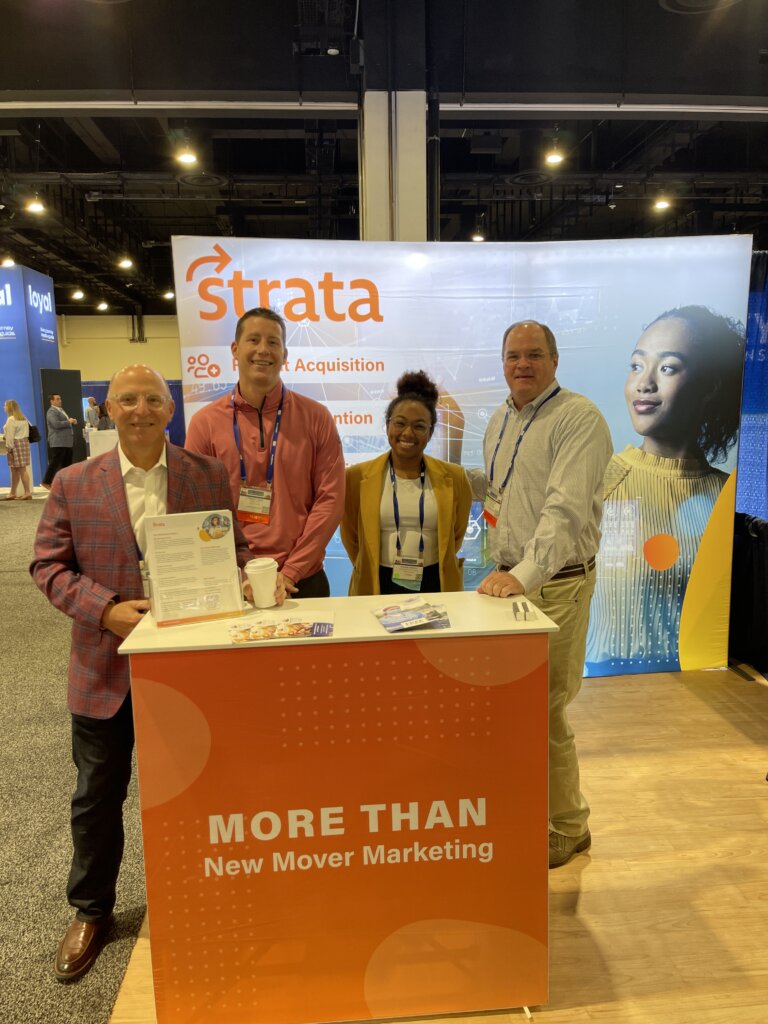
The Conference in Review
At the beginning of the show, the team first joined other SHSMD attendees at Monday morning’s keynote — delivered by Suneel Gupta, a bestselling author, host of an American Express docuseries and podcast, and Visiting Scholar at Harvard Medical School. He spoke on the importance of long-term successes coming from short-term embarrassment, and explained that by gathering people who will challenge, encourage, work alongside and coach you, you’re becoming “backable.” He also emphasized that putting yourself out there only helps you get better at what you do – and that it’s important to be “backed” by the team you’ve assembled.
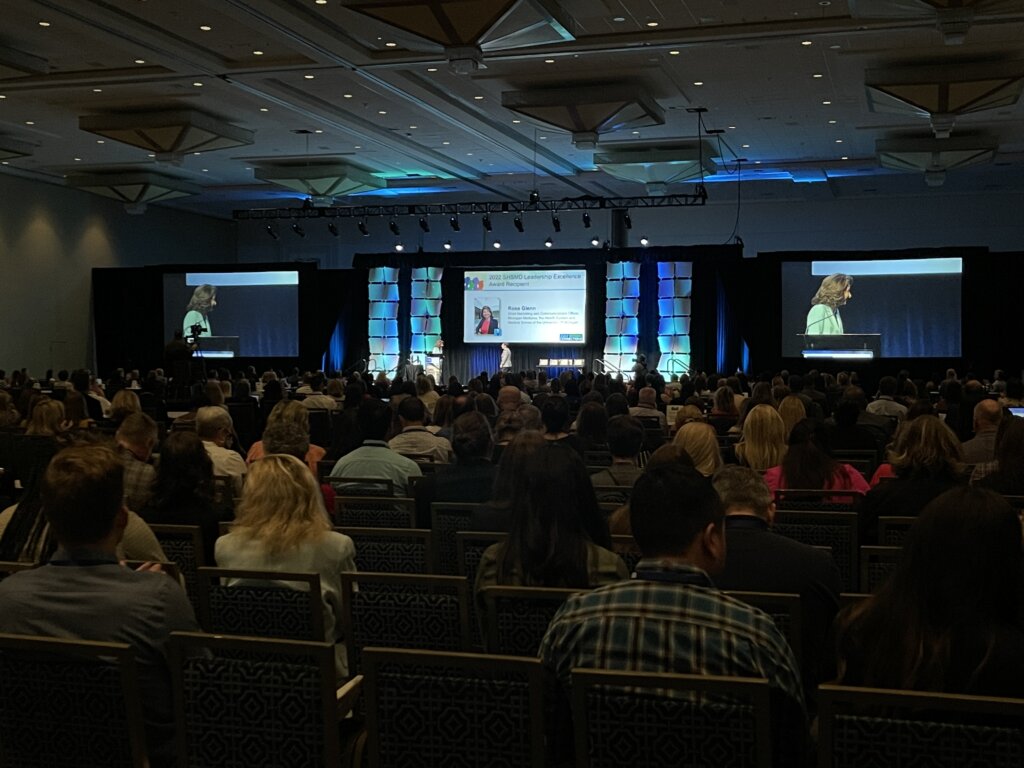
From there, the team moved to breakout rooms to learn a bit more about the needs and challenges that healthcare marketers currently face. We attended sessions surrounding digital and AI learning, nursing acquisition and retention, media buying innovations, and more.
A big topic was the idea that – as we’re continuing to traverse the digital age, it’s important that healthcare providers meet their potential patients and talent where they are. Whether someone is looking for an urgent care center, a primary care provider, or employment, the goal is to remain end-user focused. When marketing healthcare services to people in your area, it’s vital (no pun intended) to utilize demographic and psychographic data for the targeted population that your healthcare center serves. Because of this idea and the rise of ethical marketing, we’re seeing just how tactful marketing campaigns – both print and digital – need to be in order to be successful and worthwhile. Strata is well versed in this notion, and the atmosphere and chatter at SHSMD 2022 simply reiterated and expanded upon what we know to be true. Whether you need marketing that will facilitate patient acquisition, talent acquisition, or service line promotion, we’re here to make smart happen. We can help streamline your marketing to reach the talent you need and the customers you want. Right where they are.
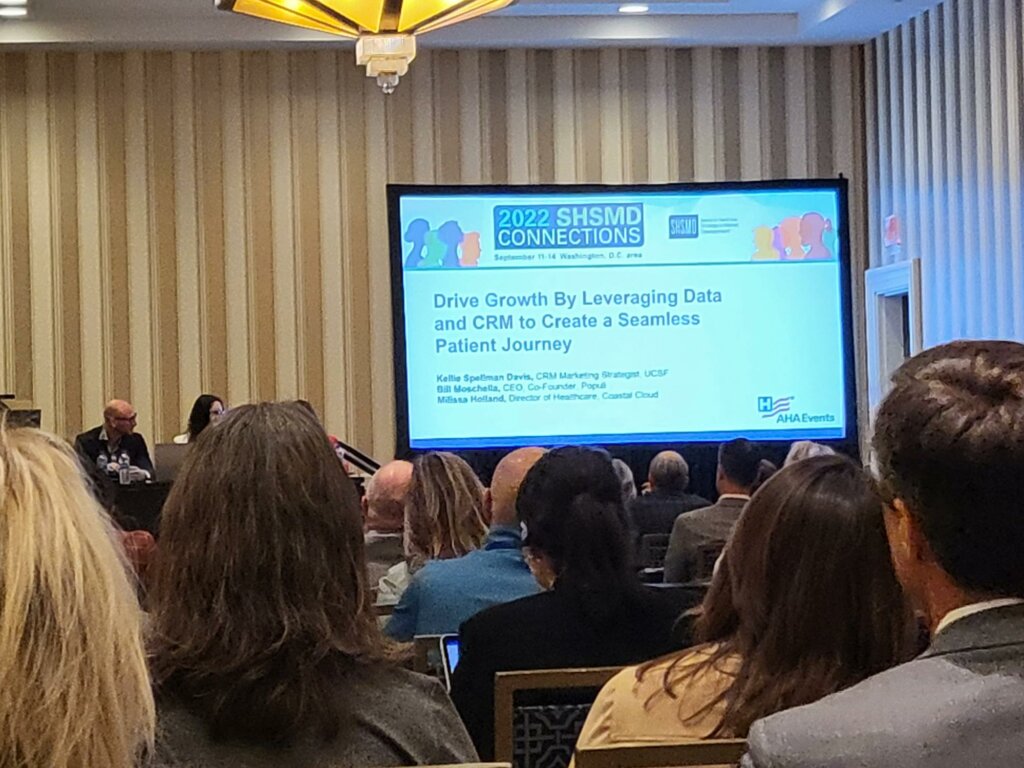
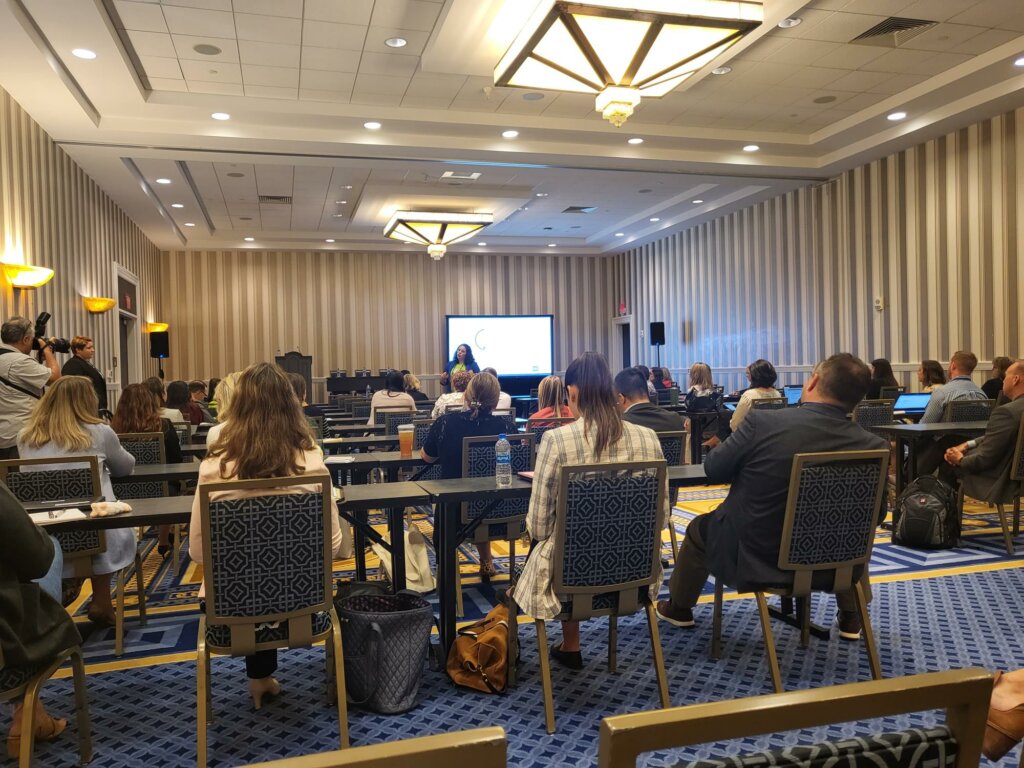
Some Final Thoughts
Last but not least – the conference reinforced the importance of good design to reach and engage your target audience! We’re glad that, here at Strata, personalized, eye-catching campaigns are right up our alley – and we have the experience and design talent to make them happen. Using demographic and psychographic data, as well as eye-catching imagery and layout, we create compelling pieces of print, direct and digital mail that follow branding specific to our clients and incorporate unique touches that help your system stand out among competitors.
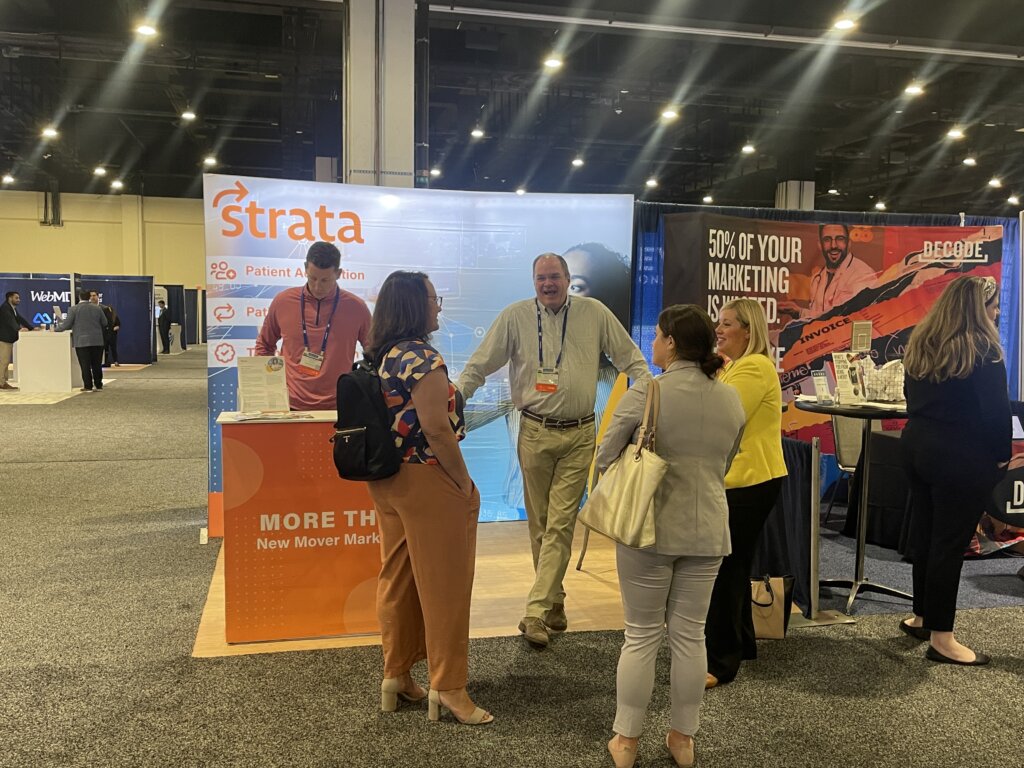
Didn’t get to discuss your healthcare needs with us at SHSMD 2022? No worries. We’re happy to have a quick chat or set up a call. Contact us today!
Not Our First Rodeo
Even though this wasn’t our first rodeo, SHSMD Connections 2021 didn’t disappoint. We had great conversations with so many show-goers, and we got to do one of our favorite things – talk new mover marketing.
In previous years, SHSMD Connections has brought quite the large crowd. Yet, with the needed precautions due to COVID-19, this year’s show created a much smaller, more intimate setting. Although we weren’t sure how the event would pan out, the smaller turnout gave Strata the chance to really chat with others in the industry, and learn more about the needs and wants of healthcare marketers.
About the Show & Our Experience
This year, two of our employees attended the conference in San Antonio, Texas from September 19-21. With Strata’s booth being front and center as guests entered the exhibit hall, our exposure was unmatched, giving us many great moments for conversation. Our bright orange and yellow (recently refreshed) colors kept the atmosphere light and fun, making it easy for the team to meet as many new contacts as possible while also connecting with familiar faces.
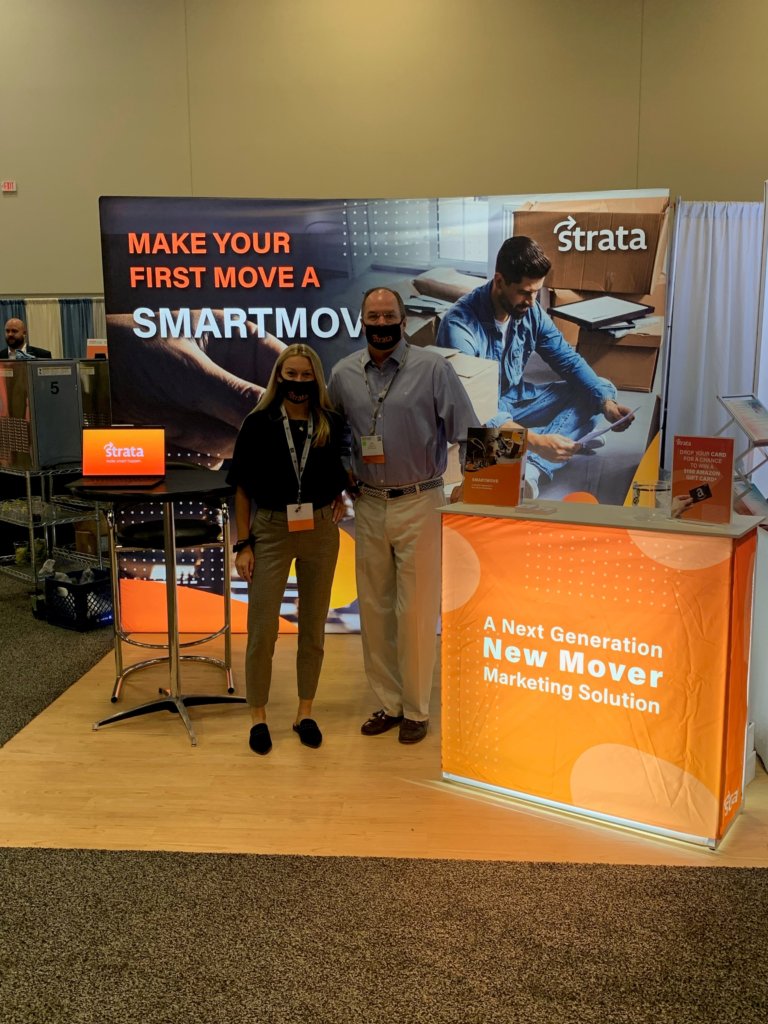
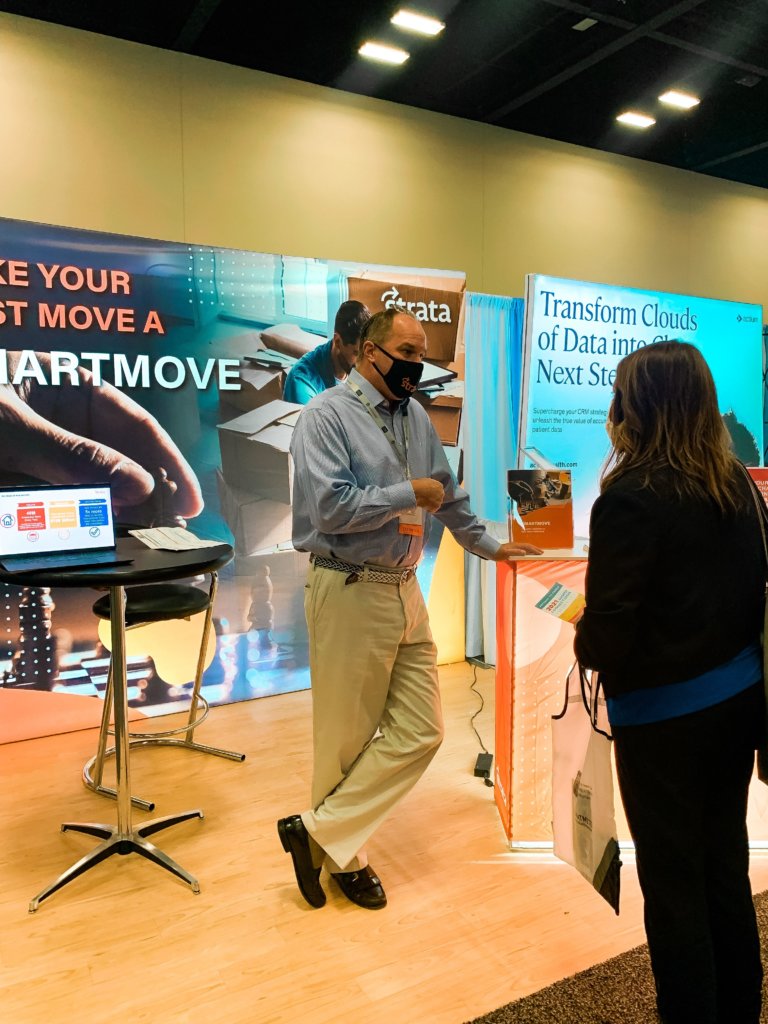
We’re really looking forward to seeing, post-show, how these connections flourish and how we can help healthcare marketers and others within the industry with their new mover marketing endeavors.
Our Takeaways
Our presentation of SmartMove and all that we offer was a huge success, and the feedback we were given emphasized the significant need for our services. Healthcare facilities aren’t just looking for direct marketing, but direct marketing that will make an impact and target the right people at the right time. Whether attendees were familiar with new mover marketing or not, our team educated them on Strata’s personalized touch and efficient processes.
But, not only did Strata come prepared to share our services – but prepared and excited to learn! On their breaks, the Strata team attended numerous breakout sessions and learned about everything from inclusion and diversity in the workplace, to problem solving, engagement, and leadership strategies. They even had the chance to hear from Burl Stamp, President and Founder of Stamp & Chase, who discussed how to properly and effectively engage with and lead teams, customers, and communities (especially post pandemic).
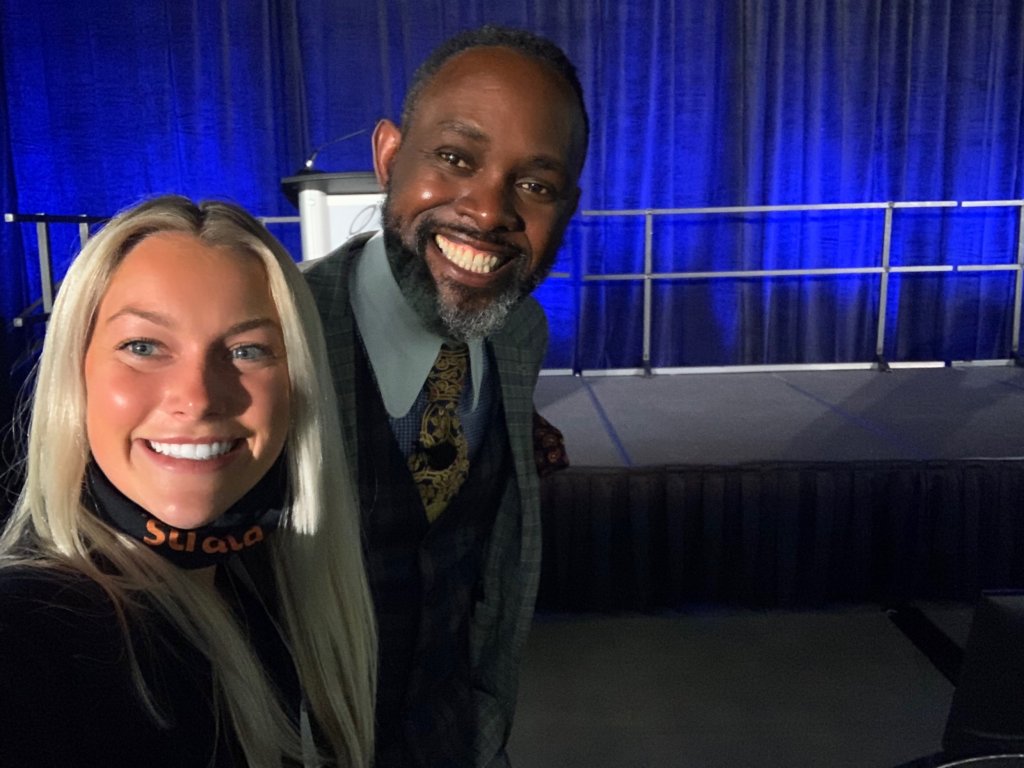
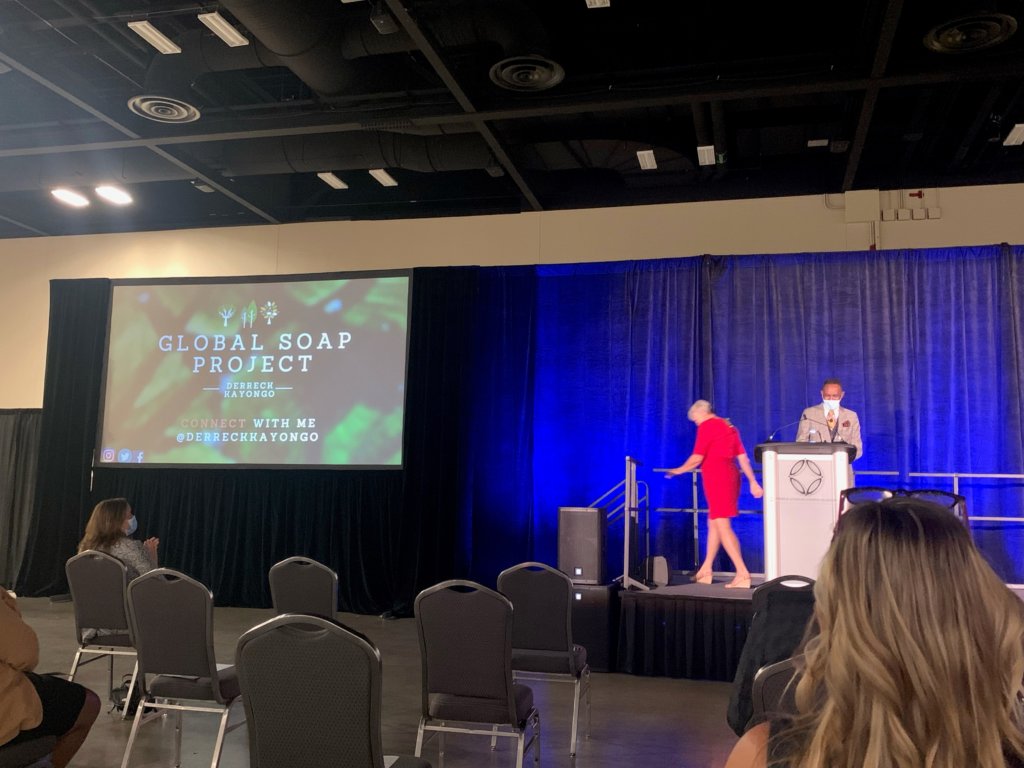
Another great session that the team partook in was Derreck Kayongo’s keynote. Derreck presented on the topic of company culture and how to tackle the subject of company diversity head on, by sharing stories of his own childhood to his own organization, the Global Soap Project. Derreck did a phenomenal job guiding the audience through diversity and inclusion problems, and how they impact the corporate bottom line. He left the crowd speechless. The team was incredibly grateful to have attended and listened in on such impactful conversations, and are so excited to not only come back with some new connections, but with takeaways to strengthen Strata’s services and culture.
Our Final Thoughts
Overall, SHSMD 2021 was a success for Strata. While it may not have looked like conferences of years past, we’re glad our team had great conversations and made solid connections with those that could attend. Not to mention, our promo items were a hit! See you next year, SHSMD!
Didn’t get to swing by and meet us at the show? Contact us today to see how we can help!
San Antonio, Here We Come!
At Strata, one of our favorite things to do is talk marketing. We’re problem solvers, and we pride ourselves on helping industries overcome their marketing challenges. With healthcare marketing being one of our many specialties, we’re excited to announce that the Strata team is heading back to the annual SHSMD Connections Conference in San Antonio, Texas from September 19th-21st, and we couldn’t be more excited!
SHSMD? What’s That?
For those who’ve never heard of SHSMD (aka the Society for Health Care Strategy & Marketing Development), it’s an AHA professional membership group that focuses on how the industry can evolve and change with new strategies, marketing, and technology, serving more than 4,000 members.
This year, SHSMD is celebrating the 25th anniversary of their annual “Connections” conference, and we can’t wait to connect with some of the industry’s best marketing and communications strategists. It’s been two years since we’ve been able to interact with these professionals in person, and we’re excited to be able to once again inform, challenge and validate their thinking, while also learning from the conference’s guest speakers from all over the country.
What We’re Looking Forward to & What We’re Bringing
This isn’t our first rodeo (even though it’s our first time going to Texas), as we’ve attended this conference for 20+ years. However, this will be our first time back with a refreshed look, thanks to our 2020 brand refresh. As marketing experts with almost 30 years of experience, we’re excited to bring our expertise to the show, and create some new, long-lasting relationships.
It’s clear that the healthcare landscape is evolving faster than ever, and to stay competitive, hospital systems need to start looking at marketing as a strategy rather than an afterthought. We plan to go into the show with an open mindset and to educate healthcare industries on the importance of New Mover Marketing and how SmartMove can help them achieve their patient acquisition goals.
If you don’t know who (or what) we do, Strata offers a wide range of client-driven solutions to help companies solve complex marketing and communications challenges. We’re a lot of things (innovators, go-getters, marketing experts), but we’re people first—and we know you are, too. That’s why we believe the best way to help a business achieve its marketing goals is by focusing on the people who work there.
Learn More
If you’re attending this year, stop by booth 216 to learn more about how Strata can help you with your marketing efforts. We can’t wait to meet you!
If you’re not attending the upcoming conference- no worries. Contact us today to discuss your own personal marketing plan from the comfort of your own home.
Best Practices & Use Cases
What We’ve Learned (So Far)
In Part 1 of the Omnichannel Marketing 101 Series, we went over exactly what omnichannel marketing is, not only including its actual definition, but how it differs from multichannel marketing, its importance, and examples of when, where, and how it’s used. In Part 2, we outlined the steps to getting started on an omnichannel campaign. From those two blogs, we hope you’ve seen that omnichannel marketing’s an excellent way to gain and retain customers, and that it’s maybe not as intimidating as it sounds, but does require research, planning, focus, and sometimes, a team of experts like us!
Now, we’re giving you the inside scoop and sharing just a few of our secrets (yes, our secrets!) on best practices for creating an omnichannel campaign that powers a unique customer experience and cultivates company success.
What Industries Can Benefit from Omnichannel Marketing?
One of the many reasons omnichannel marketing is so popular is because of its versatile nature. It can be used in many different ways across several industries. Here are just a few we’d like to highlight…
Telecom
Omnichannel marketing is often used by the telecom industry to conduct various tasks, such as helping customers make payments and send out new launch notifications. As a result, telecom companies can quickly boost revenue and drive engagement.
Travel
Travel agency customers go through numerous stages in their customer journeys. Omnichannel campaigns can help promote travel accommodations, send reminders about upcoming flights and delays, deliver other announcements, give out deals for restaurants, stores, and hotels, and keep an open line of communication that’s easily accessible to the customer.
Banking
There are several ways banks can use omnichannel marketing – from reminding their customers about impending bills and other costs, to providing account balances, and promoting new features or products. It streamlines their services and allows them to offer multi-device experiences that often save the customer time (and improves their patience).
Healthcare (Our Specialty)
Strata has helped many healthcare companies acquire and retain customers using smart and successful omnichannel campaigns. Marketing campaigns can be tough to create and execute in a highly regulated industry like healthcare, but omnichannel marketing has taken off, and more and more healthcare companies are utilizing it. Healthcare companies can use omnichannel campaigns to reach new movers in their area, connect them with physicians, send out appointment reminders, provide additional access to portals…the possibilities are kind of endless.
With all of that in mind, you can see why businesses that create and conduct omnichannel strategies have 91% greater year-over-year customer retention rates. So, even if you’re in a different industry than the four above, you don’t have to miss out. Read on to learn more about the best practices for creating successful omnichannel campaigns…
Creating the Perfect Omni-Strategy
When planning out an omnichannel strategy, it’s most important to research, collect data, and, well…thoroughly plan. Not only do you want to research and keep in mind the customer base you’re targeting, but you’ll want to examine how your customer base will experience each channel, and carefully prepare the different messages you’ll want and need to communicate to them. Like we said in our second blog of the series, knowing your customers inside and out is key to a successful omnichannel campaign. Learn their demographics, environments, behaviors, habits, and even their goals. Use analytics and CRM data to get to know your customers’ behaviors and actions. Make sure to personalize your omnichannel campaign by segmenting this audience based on your acquired data and the journey they’ll take.
On a related note, always be customer-centric. Make sure your team understands the value of consistent messaging and experiences, and is well trained, because “different customers will interact in different ways with your brand, and there is no one way to do it”. Have staff ready to not only provide assistance, but to welcome new customers, consistently engage them in new ways, and turn them into advocates of your brand with, like we said, consistent communication and customer experiences.
Don’t forget to get content (and context) right. Make sure your messages are relevant and timely. Engaging with your customers at the wrong time with irrelevant information can very easily turn them off from your brand. Communicate with customers at the most pivotal touchpoints, “from identifying and understanding a need to researching solutions, comparing products, and making a decision”. Engage with your customers when it’s applicable to them, not just when it’s best for you. Utilize CRM software to stay aware of your customers and “maintain consistent, personalized messaging with customers on whatever channel they reach you on”. Meet them where they are with a message that sparks their interest and answers any questions that they may have about your business or service. And when you can’t be there 24/7, use automation to share content, send confirmations and reminders, and communicate in other ways when triggered to.
And, maybe most importantly in our opinions, always review your metrics (which can include conversion rate, customer acquisition or retention, social media engagement, click-through rate, and more) and revise as needed. An omnichannel campaign isn’t about setting it and forgetting it, but always reviewing and improving, so set milestones for you, your team, your marketing, and your brand.
The best way to perform all of these best practices is having the right tools. Like we said, CRM technology is an excellent way to store data, keep track, and communicate. If you’re a commerce-based company or service, it’s also a good idea to use a POS system so that all of your data is stored in one place. With a POS system, you can also more easily track customer behaviors and “provide them with conveniences like remembering their passwords, storing payment information, and suggesting relevant products”.
We’ve Got You Covered
If you’re thinking this is a lot to take on all on your own, we’d recommend partnering with a knowledgeable company with a staff of omnichannel experts (like us!). Strata can help with everything omnichannel – from data sourcing to execution and production.
Think you could use our help? Feel free to visit our site or give us a call.
A Multitouch Approach for New Movers
In a world so dependent on making a first and lasting impression (before the competition), marketers have started to rely on an omnichannel approach to get the attention of new movers.
But not all omnichannel strategies are created equal. A good approach has to include:
- Direct mail offerings with multiple touchpoints and response mechanisms, like BRCs, eBRCs, and PURLs that lead to personalized landing pages
- Digital ads targeting new movers via geofencing and floodlight technology
- Email campaigns as both outreach and follow-up
It’s nothing mind blowing, but when done correctly, it can make a big impact. With that in mind, let’s take a look at a Healthcare network that we’ll call Health X and see how a multitouch, omnichannel campaign helped them successfully target and convert new movers.
Health X’s Multitouch, Omni-Channel New Mover Campaign
We’ve run recurring campaigns for Health X since 2015, including a multitouch direct mail component. Over the last five years, we’ve noticed that a second mailer (T2) received roughly an equivalent response rate when compared to the first mailer (T1).
Essentially, this means that T2 effectively doubled response rates as opposed to a campaign featuring a single mailer. Not only that, but T2 outperformed our original benchmark and in some cases, outperformed T1. This is a great example as to why multitouch marketing is so important in a complete campaign.
But where does this fit into our omnichannel marketing strategy? Via a digital component.
In both of our T1 and T2 mailers, we gave the recipients two options for their response — a conventional business reply card (BRC) and an eBRC. On average, we received about 15% of our responses via eBRCs, bolstering our total response rate when compared to BRCs alone.
And, as our results continue to surpass benchmarks year after year, we’ve been looking at new ways to get better results, like the addition of more digital ads and PURLs as consumer preferences continue to trend towards the digital.
Customize Your Campaign
This is what’s so great about an omnichannel campaign — you can add and subtract campaign elements as you see fit. Whatever your needs are, you can customize an omnichannel campaign to those needs and your budget.
So, what are you waiting for?
If you’re interested in creating a custom built, omnichannel campaign for customer acquisition, contact us to see what Strata can do for you.
Understanding How to Make an Impact in a Complex Sector
Healthcare marketing is complex stuff — marketing professionals in this sector know this.
They also know how to overcome whatever challenges these complexities present with a solid understanding of healthcare marketing strategy, beginning with their target audience. Of course, their target audience represents six generations, all the way from the GI Generation to Generation Z.
Unsurprisingly, “understanding the ins and outs of healthcare marketing strategy” isn’t exactly a simple task.
Don’t worry, we’re here to help.
Let’s break down the anatomy of healthcare marketing into two parts: healthcare marketer responsibilities and the primary problem they face with effective marketing.
Responsibilities
Website and Social
Let’s start by prioritizing. Healthcare Marketers are spread pretty thin when it comes to all that their job demands of them.
When it comes to the most basic of digital assets — social media and websites — marketers need to make sure they have their bases covered.
For websites that means ensuring mobile responsiveness, offering ample opportunity for conversion and placement of clear, obvious info hubs. It’s important to lay this groundwork while being careful not to neglect strategic SEO to beat out the competition.
In addition, they also have brand management related responsibilities with their website, particularly when it comes to website reviews.
Patient Acquisition
Healthcare marketers are also in charge of patient acquisition strategies, which can be extremely time-intensive.
Often, accessibility plays a key role in conversions, and giving potential patients ample opportunity to connect and stay connected is a big part of that. Referral programs are also a critical component of a successful patient acquisition strategy.
Mergers of two hospital systems can be a confusing time for patients and marketers alike — it’s important to emphasize practice-specific marketing as a key focus in ad campaigns, ensuring that patients will continue to receive high-quality, specialized care while promoting new assets to retain patients, and boost patient acquisition.
Taking Orders
Unfortunately, many of the priorities that healthcare marketers are faced with day in and day out are directives from their superiors. This can be anything from fulfilling collateral orders and completing sponsorship requests to updating staff bios.
These tasks tend to under-utilize the skills healthcare marketers have to offer as strategists and can be a frustrating part of a healthcare marketer’s day-to-day.
The Primary Obstacle: A Wide Audience
Now that we’ve identified the major day-to-day responsibilities of healthcare marketing professionals, it’s time to talk about their obstacle: diversity within their audience.
Everyone needs healthcare at some point. Whether it’s the GI Generation or Generation Z, the healthcare market spans each generation of consumers.
Such an ample audience is good for business, but the problem arises in communicating with that audience and the resources needed to connect with each segment as individuals. Each generation seeks information about healthcare differently, often choosing channels that are unique to them — where younger generations may respond to healthcare advertisements delivered via social media, older audiences may respond better to television advertisements.
Solving the Puzzle
Fortunately, there is a solution to this multi-generational puzzle, and it revolves around where we focus the crux of our attention.
Primarily, healthcare marketers should realize that an omnichannel approach is absolutely necessary for reaching all target audiences in effective ways — investing too much in any one medium, like social, will only neglect certain segments of your audience.
It’s important to remember that healthcare is largely about comfort, and in healthcare marketing, marketers need to communicate in the ways your audience feels comfortable with. This makes a strong case for the necessity of blending online and offline tactics.
It’s also important that healthcare marketers focus on creating solutions that are scalable and efficient. Segmenting your audience, building out personas and marketing to those personas utilizing smart MarTech solutions is a solid strategy to accomplish this.
Get the Tools
Healthcare marketing can put marketers in frustrating positions as they try to deal with the industry’s inherent challenges, but your marketing goals are far from out of reach. Contact us to see how Strata can help with the tools you need to develop a truly integrated healthcare marketing plan.
Use Marketing Technology to Build Stronger Brands from Within
Marketers in healthcare systems juggle a myriad of brand assets across an array of media. From patient relations to internal signage to external communications, your logos, font and color systems, messaging, and content really are just that – an asset that holds and conveys the organization’s value.
As such, the way you manage your brand assets helps to build efficiencies across the organization. The right digital asset management system can streamline content production and delivery, build credibility with current and prospective consumers, and strengthen your organization’s culture from within.
Cost savings and culture building become especially important during a merger. Brand assets in transition require additional oversight; further, research has found that about 75 percent of M&A deals fail to deliver their expected value, often as a result of cultural onboarding issues. In addition, research by Adobe in 2017 found that 29 percent of healthcare organizations plan to prioritize content marketing in the next few years.
A digital asset management system offers numerous benefits to healthcare providers:
- Safely store, tag, and organize content including text, image files, audio and video files
- Design workflows to accommodate complex approvals processes and improve collaboration
- Store and retrieve data to better evaluate campaign performance
- Ensure HIPAA compliance and keep a clear audit trail for regulatory agencies
Clearly, finding and utilizing the best-fit brand asset management system can create a significant positive impact during a merger – even more so if you’re also ramping up content marketing efforts at the same time.
MRM: Digital Asset Management Pioneer
While digital asset management is a strong player in brand management, it often has limitations in the breadth of content management it offers. For instance, DAM systems don’t always tie to printed output or offer ecommerce for ordering warehoused inventory – capabilities that are critical to rebranding and mergers.
One early and still reliable form of digital asset management is marketing resource management (MRM), offering organizations a platform built on a centralized database from which assets can be created and managed in house. MRM systems can handle large amounts of content and a customized platform for the specific needs of a single organization. Such systems are particularly well suited to consolidating the diverse data and resources that come together in a merger.
Asset Management for Next-Gen Content and Workflows
The core advantage of marketing resource management is that it facilitates the comprehensive management of branded assets. Combined with a user-friendly interface, MRM allows content managers to maintain brand control, stay in compliance, increase production and distribution speed, and reduce waste.
Additional tools, such as MarCom On Demand, empower marketers throughout a given network to access content they need while still enabling managers to maintain brand quality and consistency. When you minimize miscommunications; reduce waste of time, effort, and money; and maximize transparency and freedom, you not only improve your marcom operation – you make a huge contribution to your merged brand’s credibility and culture.
CCM: Improving the Patient Experience with Customer Communications Management
Designed to support outbound patient communications, customer communications management (CCM) systems (such as the one Strata Company provides) enable healthcare organizations to automate the creation of brand-specific communications. Among its many capabilities, a CCM solution can, for instance, capture patient data, create unique profiles, and build one-to-one communications in real time. This allows you to streamline, simplify, and accelerate effective branded communications on a very large scale. Further, CCM enables you to meet deadlines more easily, minimize error, and ensure regulatory compliance.
The Next Step: Ensure Success in Your Brand Merger
Strata Company offers MarCom On Demand and Corspon to enable marketers to exceed expectations and overcome challenges involved in healthcare mergers and other complex transitions. We offer dynamic templates, 24/7 cloud-based secure access, tracking and reporting, and more. Contact us to learn more.





